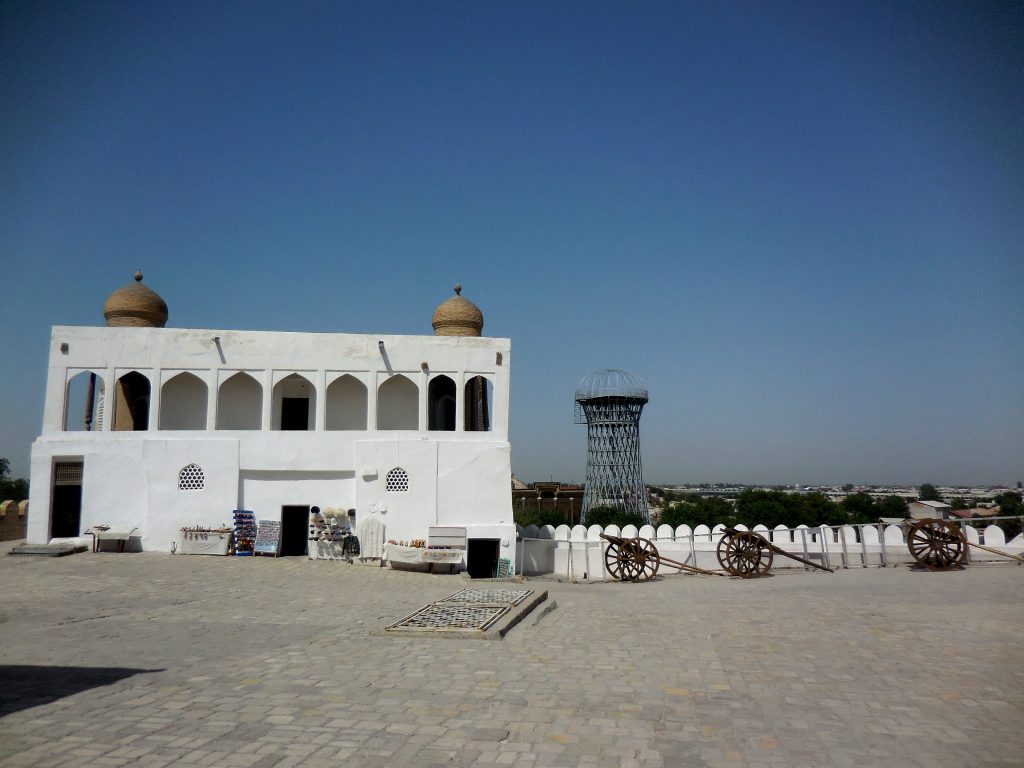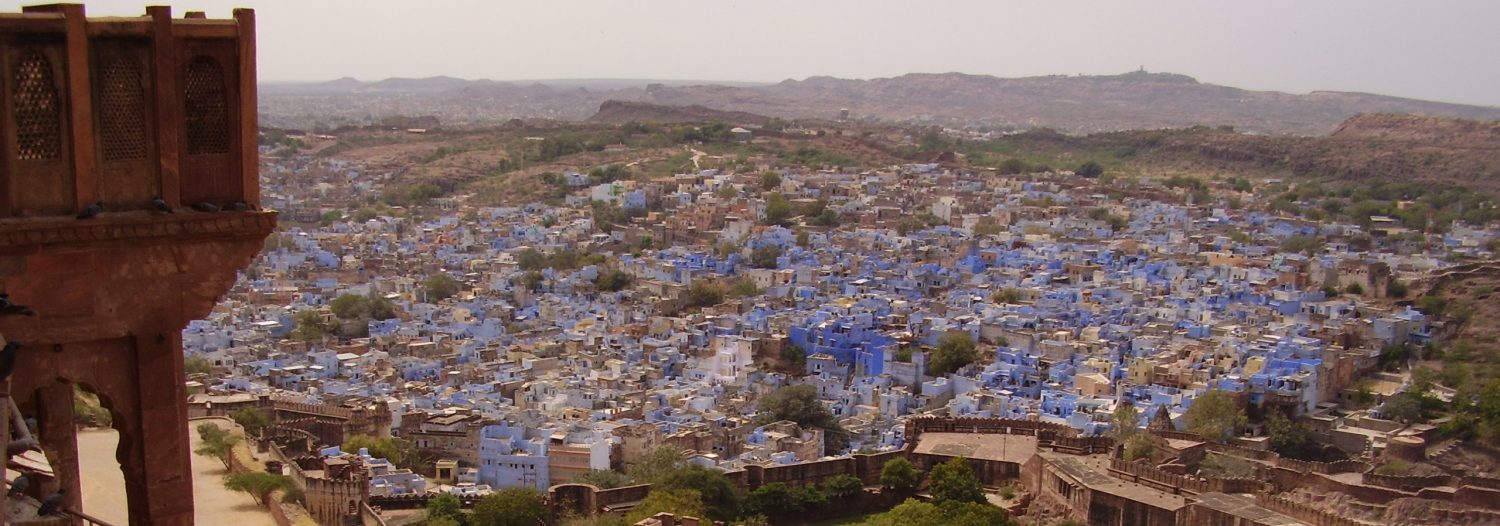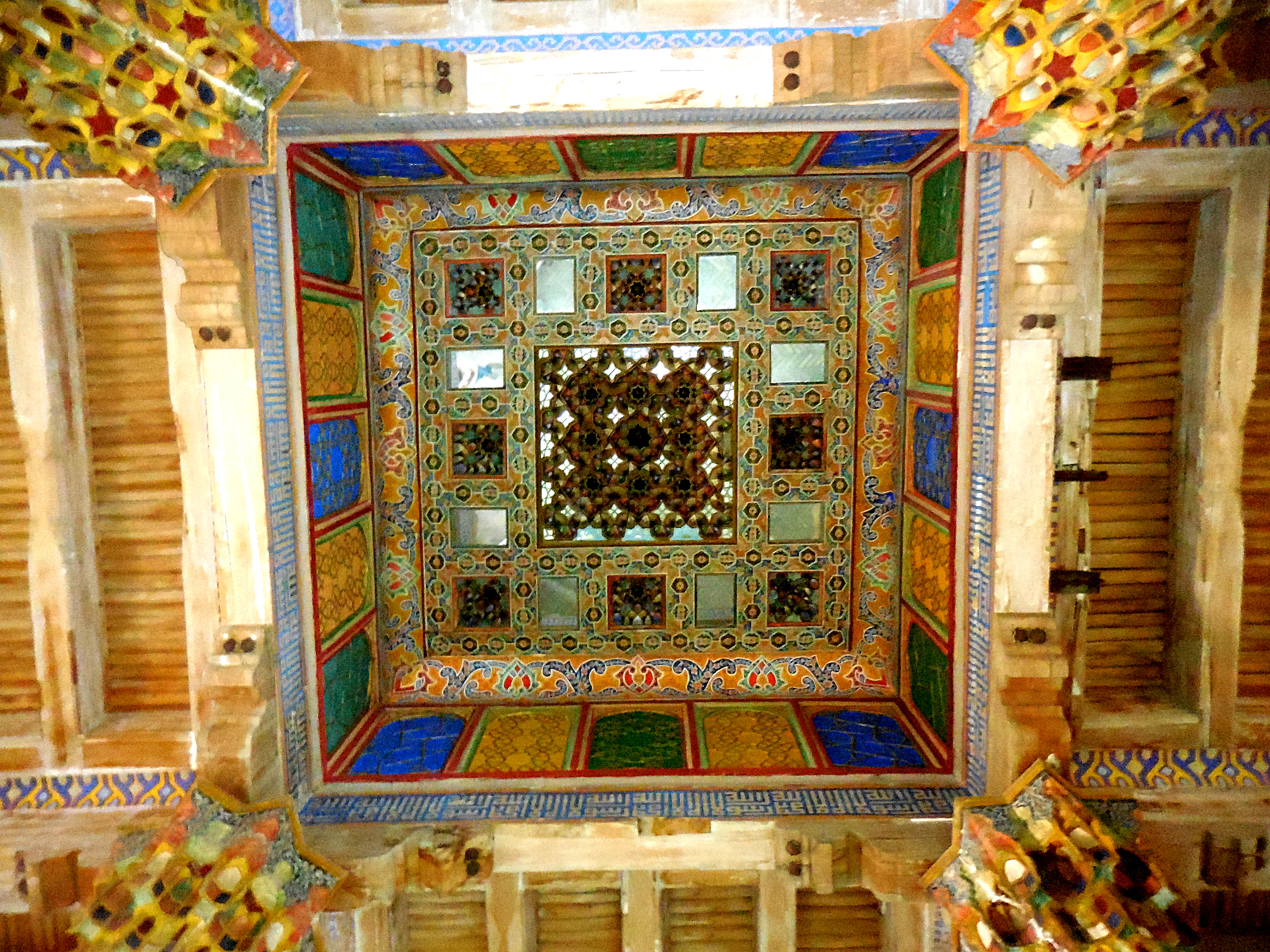The Ark Fortress, historical site in Bukhara, Uzbekistan
The Ark Fortress, historical site in Bukhara, Uzbekistan

Along the mighty walls is located in the West the oldest archaeological site of the city: the ArK Fortress, an ancient government seat. The buildings are enclosed in an irregular rectangle 3.96 hectares wide and slightly elongated from West to East, with the corner of South East cut. The walls from the base, wider than the top, are high in Registan Square from 16 to 20 meters.
To enter you pass by an ogive-shaped portal, whose white walls that contrast with the gray walls end in two tall towers similar to minarets. You cross a passage that leads through a steep climb to the terrace where several buildings are built; during the Middle Ages these had functions of Mosque, Royal Palace, prisons, bazaars … Now preserved and used as halls of the Museum of the Fortress; you can observe in fact historical objects from the Bukhara area preserved in archaeological, ethnographic, numismatic, decorative art, natural history and fine arts halls. The sacred texts are decorated with remarkable colored miniatures and the centenarian carpets with writings from the Koran.
The ancient rooms have recently been restored; you can admire walls and attics finely decorated with Islamic art and mirror mosaics; wooden columns with finely carved capitals in colorful muqarnas. In the ancient Mosque there is the Mirhab, the prayer niche, decorated with turquoise bands with sacred writings. Among the white lanes that wind through the site and local artisan street vendors, there is a square that served as the commercial nerve center of the Fortress and the large portico below which was the throne of the ruler, where he probably received an audience.

History of the Citadel
The history of the site is long and tormented and obviously has its origin in the legend of Siyavash, fled here by the wrath of his stepmother from Persia, who had tried in vain to seduce him. Forced into exile in the Turan region, the young prince fell in love with the daughter of the king of Afrasiab, reciprocated in sentiment. The father asked him to create a construction of a palace that could stand on the back of a bull as a condition for marriage. Siyavash, thanks to his intelligence, in a complicated game of lines cut from the perimeter of the back, manages to build the project of the building within the required circle. This is the origin of the Arch that, according to the excavations, dates back to the VI-III century BC.
It is said that its foundations are built around 7 pillars that follow the position of the stars of the Great Bear. The Arch was destroyed several times and only in the seventh century AD. rebuilt by the governor Bidun. In the IX-X centuries, the Samani dynasty makes the walls twice thicker and builds the towers. In the XIII century Genghis Khan succeeded in conquering and destroying the Fortress with its inhabitants. Tamerlane, once at power, orders the reconstruction of the walls; which have suffered numerous damages over the centuries due to earthquakes and bad administration, including the Soviet one.
From modern times to today. Stories of terror

In the fifteenth century, once again the Arch was rebuilt by the Shaybanid dynasty; that restore its original appearance with the addition of an oriental (Gurian) and western (Registan) gate. Many philosophers, scholars and scientists lived in the Fortress, among them Ferdowsi, Rudaki, Al-Farabi. Thanks to them there is evidence of the presence of a well-stocked library mentioned by Avicenna; but unfortunately disappeared during one of the invasions.
The stories told about the cruelty of the emirs who made their victims fall into holes full of carnivorous worms are not legends; their fate was terrible: to be eaten little by little by these creatures. In addition to Marco Polo, who stayed here for three months, other Italians stayed in this city with not much luck. Giovanni Orlandi from Parma was serving in the mid-1800s of a Russian who, I do not know why, decides to sell him as a slave to the emir of Bukhara. The poor victim receives death threats if he does not convert to Islam. He refuses and, to ingratiate himself with the emir, builds a huge clock to put at the entrance of the Arch, between the two high towers.
The emir, happy with the proposal, graces him. Orlando also manufactures a telescope with which observe the stars. Under misfortune, however, the telescope went broken and the emir calls the Orlandi urgently to repair it. The Italian arrives drunken at the court and again the emir, in a bad mood, condemns him to death; unless he converts to Islamism. Again Orlandi refuses and the emir, to show him that he is serious, makes him cut the skin from ear to ear; giving him time until dawn to think. The day after Giovanni Orlandi stands still before the trial with his strong faith and he got beheaded in the square in front of the Arch, in the year 1851. Today the clock is gone, but if you look at ancient vintage photos you can find it right there, at the entrance of the Arch.
The story of the Orlandi was certainly heard by a silk merchant called Modesto Gavazzi, captured here in 1863 and threatened with death if he did not convert to Islamism. Gavazzi refuses and gets away with 13 months of imprisonment. The story of two British officers who ended up here two decades earlier is far more unhappy. The whole of Asia was under the “Great Game”, which is international spying system described well in the beautiful book by Kipling, Kim. In Central Asia, all foreigners were considered spies in the service of the West; anyone who was captured, hardly brought home the skin.
The unlucky English officer finds himself in the black hole full of carnivorous worms, only because he does not get off his horse once he entered in Bukhara, while the other because went to look for him. After some months, already without skin, they are beheaded in 1842 under the order of the emir to celebrate his victory over local enemies. To understand the fate of the two English, two years later, a German Reverend arrives, Joseph Wolff, who, thanks to his posture and cunning, manages to take his head home with the news that London seeks.
In fact, he presents himself with canonical clothes, a machine gun on his head, a Bible in his right hand, a pastoral stick on his left. Once in front of the emir, instead of making three genuflections, reciting “Allah Akbar” as requested, he makes thirty of them repeating “Peace to the great King”. The emir is pleased and lets him return to Europe.
Modern era
The Fortress was an active and populated center, until 1920. The Bolshevik troops, during the revolution, assault and destroy the site, arriving with what are called iron birds (the first time that locals see planes). Leading the enterprise is Michail Frunze, who expels Bukhara on September 2, 1920 and defeats the last emir of Bukhara, Sayyid Alim-Khan.
It was thought to have him captured, but the emir manages to escape to the fortress of Hissar and, from there, in Afghanistan; ordering also the killing of the landlord who had welcomed him. It is said that the emir manages to bring the ammount of 175 million dollars into a foreign land with jewels, stones and gold bars. Alim Khan died in exile in Kabul in 1947.
For further info on Bukhara and Poi Kalyan complex, click here.
Foto by Eva Zalesakova
Source: A.V., Bukhara, the city and the legends, Davr Nashriyoti, Tashkent, 2014
Tiziano Terzani, Buonanotte Signor Lenin, TEA, 1992, pp.289-295.
www.centralasia-travel.com/en/countries/uzbekistan/places/bukhara/ark_fortress


Pingback: Madras Kukeldash, Khanaka and Madras Nadir Divan-Begi, Bukhara.
Pingback: Madras Kukeldash, Khanaka and Madras Nadir Divan-Begi, Bukhara. | Erica Leoni
Complimenti!… eccellente contributo alla conoscenza dei luoghi e quindi delle culture. Grazie.
Maurizio Militello
Grazie a lei!